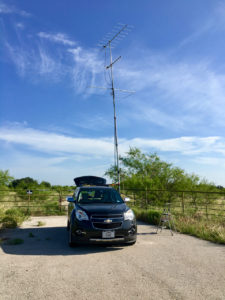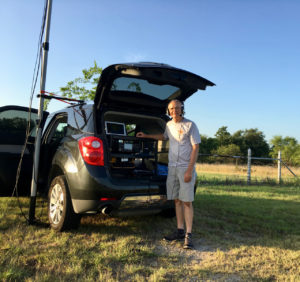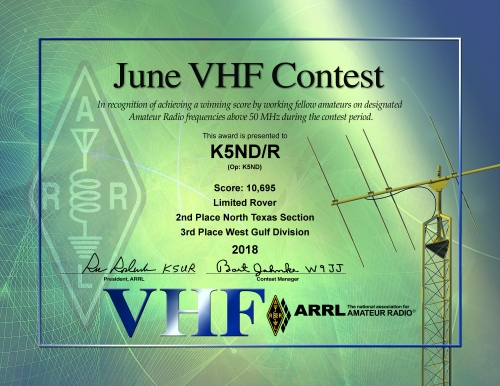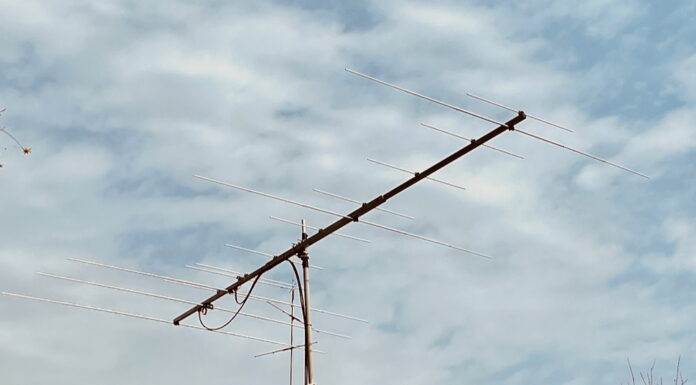Overall, I managed to get 145 contacts in the log, activated 7 grids, totalled 69 multipliers, and scored 11,109 points. Not a bad effort. But lots of room for improvement.
HamCom 2018
The ARRL June VHF Contest annually coincides with HamCom here in Dallas. So I stopped by on Friday to see new and used equipment, visit with my Icom buddies, meet Randy Wing, N0LD, and see his presentation on VHF Rover Operation. He did a great job covering overall VHF contesting and going into the detail on his own rover operations.
He’s one of my inspirations for getting into VHF rovering. So it was fantastic to meet him and to gain further insight into rover operations.
Early Saturday Operation

I got up very early Saturday to set up my rover station in front of my home so that I could work Wyatt AC0RA and his Grid Activation from EL58 — at the very tip of the Mississippi Delta. I’d previously worked his DX partner Clayton W5PFG on satellites from this rare grid.
This 6 meter QSO was accomplished on MSK144. From my perspective, it took a little bit of fumbling around with WSJT-X to get it to work — operator and set up issues. But we got it accomplished. Thanks, Wyatt and Clayton for a new grid.
That early Saturday set up also served to sort out what was missing and what did or did not work. Even so, I discovered or encountered a few issues during my rover operation.
Computer Issues
Fortunately, VHF contests are not like HF contests, at least for me. HF contests typically involve thousands of QSOs and from that perspective need lots of logging software features to help prevent errors and capture the right information. On the other hand, VHF contests, again for me, number QSOs in the hundreds. So paper and pencil could probably work.
For VHF contests I use N3FJP’s VHF Contest Log. It worked great in the January VHF contest. Plus, it allows importing ADIF files. So I could readily add my WSJT contacts. So, prior to the contest I did all my updates and in the process discovered a hard “drive failing soon message” along with corruption of some basic Windows functions. That caused me to ditch the Windows laptop and bring along my MacBook.
It actually worked pretty well. I ended up using MacLoggerDX in contest mode for the logging, WSJT-X for digital contacts, and JT-Bridge to transfer the WSJT-X contacts to the log in real-time.
VHF Rover Results
Six meters was pretty dead on Saturday but very active on Sunday. I managed to work 94 QSOs from 47 grids. Of those, 46 QSOs were via WSJT-X — more on my challenges there later.
Two meters is certainly the go-to band in January and September contests. But when six is open, fuhgeddaboudit. Even so, I worked 35 QSOs and 10 grids, all on phone. A big help here were K5QE and K5TR who answered their phone when I called and worked me on multiple bands.
Seventy centimeters always helps out your score. Here I logged 16 QSOs and 5 grids. Again thanks go to K5QE and K5TR for working the bands with me.
Here’s how each of my rover grids did:
Saturday
- EM11 — 18 QSOs
- EM12 — 19 QSOs
- EM21 — 11 QSOs
- EM22 — 16 QSOs
Sunday
- EM13 — 22 QSOs
- EM03 — 27 QSOs
- EM02 — 32 QSOs
The improvement on Sunday was entirely due to six meter openings that resulted in WSJT-X and phone QSOs. My CW operations did not happen due to a comedy of errors.
I have a wonderful Palm Pico Paddle for rover operations. It worked great in the January contest, but that was with my IC-910H. This time I had my IC-9100 and in my first grid tried to plug-in the key — wrong connector. So for Sunday I brought along the adapter, plugged it in, and realized that I needed to change the IC-9100 settings to allow a direct paddle connection rather than the WinKeyer I use at home. Instead of twiddling with that, I just went without CW. One person called me on 2 meters, that I could hear. So I guess I only lost one QSO. Lesson for next time.
I ran into only one issue with my rover route. The EM22 location was a church parking lot with an excellent elevation over the surrounding terrain and clear horizon. When I arrived, they had started building a new church with steel everywhere and a nearly full parking lot. So I motored down the road and found a roadside park that worked well.
Heat Burn Out

My rover setup is outdoors, at the back of my SUV. That allows for easy access to the mast and quickly pointing the antenna in the right direction. But it does get hot out there in June in Texas. Actually, it was 95+ degrees most of the time.
On Saturday, my route took me in just minutes from EM11 to EM12 to EM21. This was not enough time to actually cool down in the air conditioning. So by the time I headed to EM22 I was seriously contemplating shutting down for the day. But the 45 minute drive cooled me down sufficiently to revive my spirits. Plus, the sun was setting which cooled things a bit.
On Sunday, starting early in the morning worked well. I had the same quick trip between EM13 and EM03 followed by an hour drive to EM02. But, by then it was hot and I was standing on an asphalt parking lot. Not only that, but my next planned location, in EM01, would have taken an hour to reach as well as added significantly to my drive home.
All that, coupled with my WSJT-X frustrations and the usual crazyness on six meter phone pileups convinced me to end the rover early and find a beer at home.
WSJT-X Burn Up
My burn up here was due to three major issues. The first is that the ARRL June VHF Contest rules state:
[perfectpullquote align=”full” bordertop=”false” cite=”” link=”” color=”” class=”” size=””]3.5.4. Rovers MUST sign “rover” on Phone and /R on CW and digital modes after their call sign.[/perfectpullquote]
The second, which I learned after the contest, is that WSJT-X only allows type 1 suffixes from 0 to 9 along with /A and /P. Plus, WSJT’s auto sequence in NA VHF Contest mode runs from either CQ or calling someone directly to the TX 3 message, which is DE K5ND/R R EM02. It does not include the station’s call sign to whom you are responding.
Note that this occurs regardless if you’ve selected Full Call in Tx1, Full Call in Tx3, or Full Call in Tx5 only in the General Settings tab. This is true in NA VHF Contest mode.

That response resulted in lots of confusion on the other side of the QSO. Some didn’t recognize that I was calling them. Others figured I must be calling them and at the end of the QSO I would get two or three stations sending their 73 message to me. I can’t wait to see my Log Checking Report for all the missed QSOs that should have been in my log.
I will note that I tried turning off auto sequence and tagging the appropriate button. Although, it seemed that at least in NA VHF Contest mode it was going to auto sequence automatically.
The third issue, which many encountered, was that some stations were running VHF Contest mode and others were not. That resulted in uncovering the difficulty mid-QSO and changing modes, re-generating messages, and then starting again. This, in turn, resulted in missed QSOs as stations either left the QSO in frustration or sometimes we just lost propagation. I suspect the former was the predominate issue.
Meeting People and Explaining VHF Rover Ops
In my travels quite a few people stopped, rolled down their window, and asked me what I was doing. I spent time explaining amateur radio, competitions, and rovering. Some were enlightened and I’m sure a few wondered about my sanity. One guy with a ham plate stopped by, asked what I was up to and gave me a QSO on 146.52. That was helpful.
Next Time
I had fun despite the heat and WSJT-X issues. I also learned a few things for next time.
For the June VHF contest, I will see if anything has been resolved with WSJT-X that helps rovers and those working the rovers. If not, I’ll probably set up shop somewhere and operate from a single grid as a Single Op.
For January and September VHF contests, I’ll do some roving with 2m and 70cm. I’ll also consider adding at 1.25m transverter and antenna. That might also set me up for the UHF contest. Both those would also encourage me to add a 23cm antenna, since I already have that band on the IC-9100.
Thanks
Thanks to everyone who worked me and those poor souls who tried to work me on WSJT-X and failed due to my poor button pushing.
The results are in and I managed to place 3rd in the West Gulf Division and 2nd in the North Texas Section. Not too bad among some excellent competition. This is a good motivator for next time.










Yes – 222 and 1.2.
Looking into 222 MHz transverters and antennas now as well as a loop yagi for 1296 MHz. Thanks for the QSOs during the contest. 73, Jim, K5ND